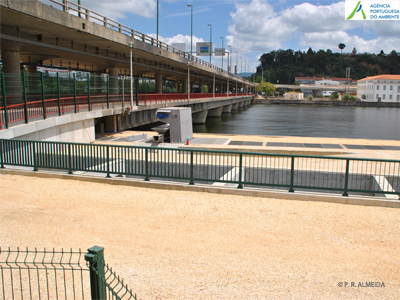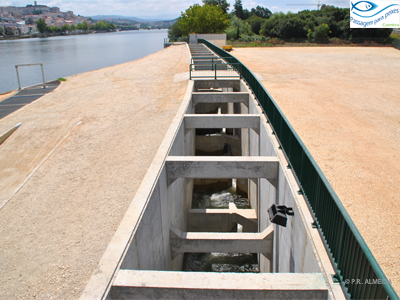Fish pass at the Açude-Ponte dam

The Coimbra Açude-Ponte dam is 6.20 m high and it was built in River Mondego mainly for flood control, water supply, industrial and agricultural water uses. Since its construction, this structure blocked the migration of several commercially and ecologically important species, among which the sea lamprey, the allis and the twaite shad and other diadromous and potamodromous fish, limiting the distribution of these species inhabiting the Mondego river basin.
The first phase of the habitat restoration plan for diadromous fish in River Mondego was the construction, in 2011, of a vertical-slot type fish pass, managed by the Portuguese Environment Agency (APA). This infrastructure represented a total investment of € 3 466486, with an European contribution of € 2 599 864 in the framework of the European Fund for Regional development (FEDER - Fundo Europeu de Desenvolvimento Regional).
Since it is operational, its' efficiency for the target species is being evaluated using several methodologies, namely visual counts, bio-telemetry (radio, physiological electromyogram-EMG, PIT Tags), electrofishing surveys and inquires to the local professional fishermen.
 Açude-Ponte Dam. |  Fish Pass at the Açude-Ponte Dam. |
Results from the first three years of post–operational monitoring shows that the fish pass actually increased the available area for diadromous species in River Mondego. Visual counts revealed that, in 2013, 1407204 fish successfully negotiated the infra-structure (ca. 900000 in the upstream direction). These included several autochthonous species, namely, sea lamprey, shads, European eel, brown/sea trout, barbel, nase, mullet.
During the 2013 spawning season 8333 lampreys used the fish pass, and in 2014 this number increased to nearly 22000 lampreys. A statistical model developed with this data clearly shows that the dam discharges significantly influence the migratory behavior in the vicinity of the fish pass, limiting its efficiency during high discharge periods. About 7500 Alosa sp. specimens used the fish pass in the 2013 spawning season, whereas only 3406 individuals used this infrastructure in 2014.
Electrofishing campaigns conducted before and after fish pass construction detected a sixteen time increase, between 2012 and 2014, in the relative abundance of sea lamprey larvae upstream the dam.
Results from this study can help to improve the success of the Açude-Ponte dam fish pass in restoring migratory fish populations in River Mondego and are being promoted as what is considered to be a reference approach to other similar structures spread along Portuguese rivers.
| Allis Shad in the fish pass at the Açude-Ponte dam. | Sea Lamprey in the fish pass at the Açude-Ponte dam. |